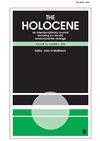联合国教科文组织世界遗产波尔图湾及其周边地区(西地中海科西嘉岛西北部)中晚全新世海岸形态演化、植被历史和土地利用变化
IF 1.8
3区 地球科学
Q3 GEOGRAPHY, PHYSICAL
引用次数: 0
摘要
对科西嘉岛西北侧的两个沿海地区进行了调查,以重建其全新世中期至晚期的景观演变以及人类占领的历史。特别关注海岸线迁移和植被历史以及土地利用的研究。钻了三个钻孔,最大深度为4.20 m,实验室工作包括软体动物和花粉/NPP的鉴定以及沉积学分析。年代地层学基于一系列18个放射性碳年代测定,能够重建世界遗产地北部Fangu河口过去6000年和南部Girolata海岸平原过去4000年的环境。根据钻孔年代地层学分析,为每个场地建立了海岸线流动性的古地理重建。此外,还建立了Girolata和Fangu两个原始花粉和NPP图。这些结果表明,人类活动开始对当地植被覆盖率产生重大影响。Girolata约2500年BP,Fangu约2000年BP。特别令人感兴趣的是,我们的工作记录了罗马时代科西嘉岛Girolata的第一个完整花粉序列:首先,在罗马共和国时期(公元前500年至公元前0年),观察到谷物、葡萄藤的开发和畜牧业的发展,随后在罗马帝国时期(公元0年至公元500年),几乎只种植Olea sp。在此之后,并利用科西嘉岛西北部获得的其他区域花粉研究,我们提出了过去6000年复杂的人类与环境相互作用的区域演变。我们的研究结果表明,从公元11世纪到16世纪,区域森林衰退达到峰值(全新世晚期记录的最强烈事件),这可归因于比萨和热那亚统治该岛期间对木材资源的开采。本文章由计算机程序翻译,如有差异,请以英文原文为准。
Mid- to Late-Holocene coastal morphological evolution, vegetation history and land-use changes of the Porto Gulf UNESCO World Heritage site and its surroundings (NW Corsica Island, Western Mediterranean)
Two coastal areas located on the North-Western side of Corsica Island have been investigated to reconstruct their Mid- to Late-Holocene landscape evolution together with the history of human occupation. Particular attention has been paid to the study of shoreline migration and vegetation history alongside land-use. Three boreholes were drilled to a maximum depth of 4.20 m and laboratory work comprised the identification of molluscs and pollen/NPPs as well as sedimentological analyses. Chronostratigraphy is based on a series of 18 radiocarbon datings and enabled to reconstruct the environments in the Fangu Estuary to the north of the World Heritage site over the last six millennia, and over the last four millennia on the Girolata coastal plain to the south. Palaeogeographic reconstruction of shoreline mobility is established for each site based on borehole chronostratigraphy analysis. In addition, two original pollen and NPPs diagrams have been established for the Girolata and Fangu sites. These reveal that anthropogenic activities began to significantly impact local vegetation cover ca. 2500 years BP at Girolata, and ca. 2000 years BP at Fangu. Of particular interest, our work records the first complete pollen sequence in Corsica for Roman times at Girolata: first, the exploitation of cereals, grapevines and the development of husbandry is observed during the Roman Republic (500 BCE–0), followed by the almost exclusive cultivation of Olea sp. during the Roman Empire (0–500 CE). Following this, and using other regional pollen studies obtained for NW Corsica, we propose a regional evolution of the complex human-environment interactions for the last six millennia. Our results reveal a peak of regional forest decline (the most intense event recorded for the Late-Holocene) from the 11th to the 16th centuries CE which can be attributed to the exploitation of wood resources during the Pisan and Genoese dominations of the island.
求助全文
通过发布文献求助,成功后即可免费获取论文全文。
去求助
来源期刊

Holocene
地学-地球科学综合
CiteScore
4.70
自引率
8.30%
发文量
106
审稿时长
4 months
期刊介绍:
The Holocene is a high impact, peer-reviewed journal dedicated to fundamental scientific research at the interface between the long Quaternary record and the natural and human-induced environmental processes operating at the Earth''s surface today. The Holocene emphasizes environmental change over the last ca 11 700 years.
 求助内容:
求助内容: 应助结果提醒方式:
应助结果提醒方式:


